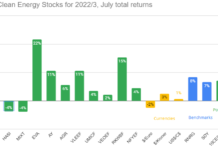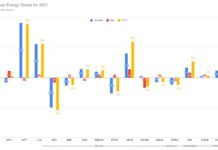The market has fallen sharply, and Solar stocks have fallen even more following rumors that Congress will pass the Energy Bill without the Production Tax Credit or Investment Tax Credit. Given this volatility and Renewable Energy’s reputation for profitless startups, now might seem like an excellent time for a risk adverse investor to abandon the sector altogether.
Not so. Even if all tax credits and other incentives for Renewable Energy were to be removed, the underlying drivers of Alternative Energy remain firmly in place: Rising energy prices and decreasing reserves, the need to reduce our Greenhouse gas emissions to avoid the worst effects of Global Warming, and the likelihood of continued nationalizations, or the more subtle nationalization by taxation/royalty increases practiced in more developed countries.
Defensive Alternative Energy Sectors
Without direct government support, the sectors likely to suffer the least are the ones which are already economic. Top of the list is Energy Efficiency, which might actually gain from a cut in subsidies for renewable energy, as green House Gas production efforts shift away from Renewable. Among renewable energy technologies, Geothermal, small Hydro, and Wind are already cost competitive with fossil competitors in the best locations. Biomass and Biodiesel are also cost competitive when using waste as feedstock.
Most of the best companies in Energy Efficiency (especially when it comes to energy Efficient Buildings) tend to be systems integrators, large companies with strong energy efficiency arms. These companies have an added advantage for a risk- adverse investor: built-in diversification. This brings me back to a way even the most cautious stock market investor can participate in the Alternative energy Boom: By buying the companies in my Blue Chip Alternative Energy Portfolio: large, profitable companies that stand to gain from increasing energy prices and carbon regulation.
Charles and I have added a few to my original list since the original article. Here is the updated list, along with links to articles describing why we like each of the stocks:
Investing, Like Life, is a Compromise
This portfolio is being heavily weighted towards engineering, industrial, and utility companies. However, most of these companies have truly international operations, insulating them from a likely US recession and declining dollar. They’re also uniformly profitable, often with low price to earnings ratios, and relatively high dividend yields.
Nor ate these as green as a company like Interface (IFSIA). A diversified investor must make compromises. Those compromises can be made at the portfolio level by mixing some dirty stocks in with the clean ones, or they can be made within the companies themselves.
Our choice is not between a diversified portfolio of green companies and a diversified portfolio of green-ish companies representing compromises of our green ideals. In reality, our choice is between a risky portfolio of highly volatile green stocks, and a much better diversified portfolio of companies working to help the environment in many way, but nevertheless embodying real-world compromises of green ideals.
The Priuses of the Stockmarket
These Blue Chip stocks are the Hybrid cars of the stockmarket. While they are a lot cleaner than a normal car, they still burn gasoline. Eventually we may all be able to drive Electric Cars charged with Wind or Solar. Until that day comes, we’d be a lot better off if most people drove hybrids or diesels. Just as the cost of ownership and the environmental impact is lower with a high-mileage car, the environmental impact of these companies is lower than most, and I expect those benefits to translate into better returns for investors in the long run.
If we’re lucky, we can use our profits to all buy Tesla Roadsters and charge them with Solar.
DISCLOSURE: Tom Konrad and/or his clients have positions in these companies mentioned here: GE, SHCAY, JCI, WMI, AA, CAT, DD, FPL, ADM, DE, SI, OC, ABB, MGA, BGC, PWR, ITC, DOW, HON, TRN.
DISCLAIMER: The information and trades provided here are for informational purposes only and are not a solicitation to buy or sell any of these securities. Investing involves substantial risk and you should evaluate your own risk levels before you make any investment. Past results are not an indication of future performance. Please take the time to read the full disclaimer here.








An email from a reader:
Unfortunately, most of these companies do not specifically break out the percentage of revenues or profits from their alternative energy ctivities. Also, these activities are not well defined, especially energy efficiency. Using Owens Corning as an example, insulation is an energy efficient product, but if only a thin layer is installed, or there is not a complementary air barrier, you won’t end up with an efficient house.
Some of this information is available on company websites, but be wary of exaggeration about what constitutes a green technology. Is IGCC
or nuclear green? Not if you ask me, but they are if you ask the companies which sell the technology.
Misunderstanding.
I was asking about % of each of the companies IN YOUR portfolio!!!
IOW, do you have any suggestions on how much of each company to acquire in the portfolio?
Good Question. My portfolio is very complex, and I write a lot of cash-covered puts and covered calls to manage my exposure to specific stocks, so precise numbers are impossible. But I’ll rank my exposures to these stocks on a small/medium/large basis, with small less than 0.2%, and large more than 1% exposure (or the equivalent via options)
Small exposure: AA, FPL, WMI, ADM, ABB
Medium Exposure: PHG (not in the list, but I should have included it), BGC, CAT, DD, DE, JCI, OC, PWR, SI, TRN, UTX
Large Exposure: GE, SHCAY
Note that there are some in Client’s portfolios that are not in my own, and that the %ages vary. Also note that I wouldn’t suggest that ANYONE try to replicate my portfolio… I have literally hundreds of positions in different stocks, because I find that owning a little of something makes me pay more attention. Also, the proportions in my portfolio are somewhat a matter of chance due to the option-based market timing techniques I use… If I decide I like a stock, but the price keeps rising, I often end up not owning any or just a tiny amount.
I keep planning on writing an article about my timing techniques, but I have not yet.
A more useful measure might be what I do for clients. I often target about 1-3% of their portfolio in each of these stocks, with higher percentages of fewer stocks in smaller portfolios to save on comissions. Your needs may be different.
You may be missing a large Transmission and Distribution player that is benefiting from the congressionally mandated upgrade of the grid–
Cooper Industries controls the domestic market (along with ABB). The stock is cheap at 15x 07 and 13.5x 08.
Be careful of tax hit the company may take due to its
Bermudian incorporation and recent corporate tax law change regarding repatriation…
Thanks JJ,
I’m actively looking for new T&D plays, so I’ll definitely look into this one.
Thank you for sharing this information! Can you tell me where diesel engines fit in this chart?